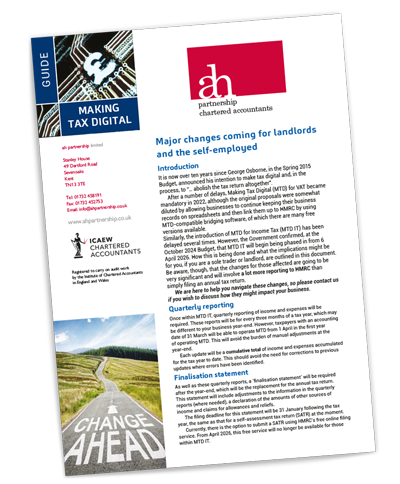Major changes coming for landlords and the self-employed
Introduction
It is now over ten years since George Osborne, in the Spring 2015 Budget, announced his intention to make tax digital and, in the process, to “… abolish the tax return altogether”.
After a number of delays, Making Tax Digital (MTD) for VAT becamemandatory in 2022, although the original proposals were somewhat diluted by allowing businesses to continue keeping their business records on spreadsheets and then link them up to HMRC by using MTD-compatible bridging software, of which there are many free versions available.
Similarly, the introduction of MTD for Income Tax (MTD IT) has been delayed several times. However, the Government confirmed, at the October 2024 Budget, that MTD IT will begin being phased in from 6 April 2026. How this is being done and what the implications might be for you, if you are a sole trader or landlord, are outlined in this document. Be aware, though, that the changes for those affected are going to be very significant and will involve a lot more reporting to HMRC than simply filing an annual tax return.
We are here to help you navigate these changes, so please contact us if you wish to discuss how they might impact your business.
Quarterly reporting
Once within MTD IT, quarterly reporting of income and expenses will be required. These reports will be for every three months of a tax year, which may be different to your business year-end. However, taxpayers with an accounting date of 31 March will be able to operate MTD from 1 April in the first year of operating MTD. This will avoid the burden of manual adjustments at the year-end.
Each update will be a cumulative total of income and expenses accumulated for the tax year to date. This should avoid the need for corrections to previous updates where errors have been identified.
Finalisation statement
As well as these quarterly reports, a ‘finalisation statement’ will be required after the year-end, which will be the replacement for the annual tax return. This statement will include adjustments to the information in the quarterly reports (where needed), a declaration of the amounts of other sources of income and claims for allowances and reliefs.
The filing deadline for this statement will be 31 January following the tax year, the same as that for a self-assessment tax return (SATR) at the moment. Currently, there is the option to submit a SATR using HMRC’s free online filing service. From April 2026, this free service will no longer be available for those within MTD IT.
